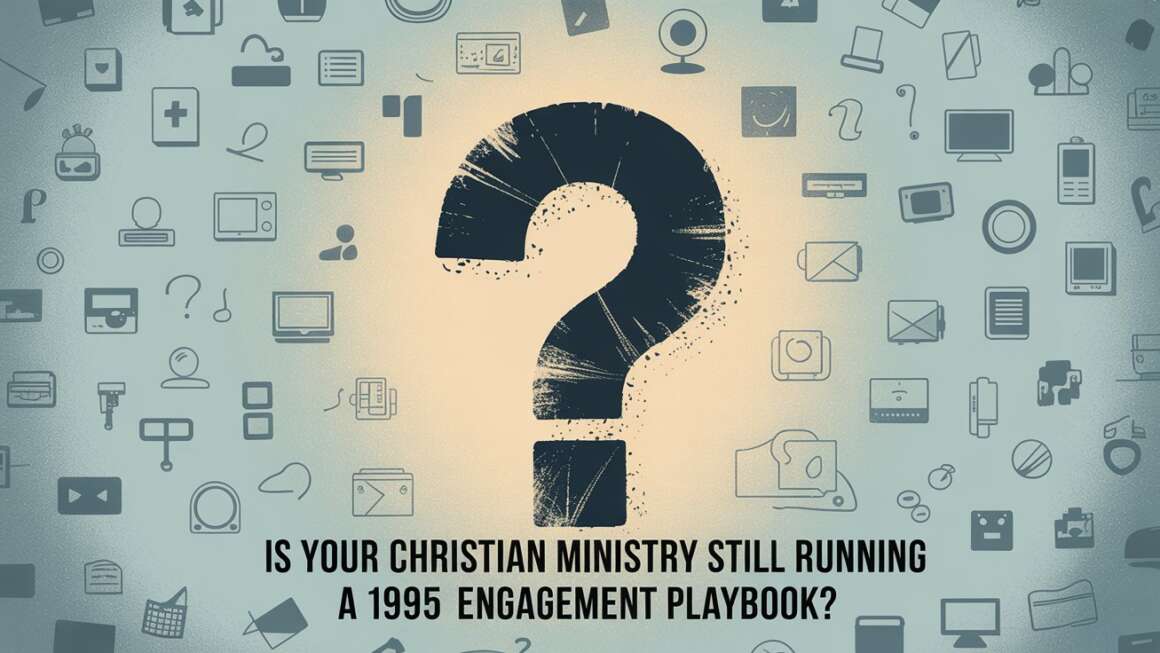So you might already be thinking about what life and ministry will be like when you step back into your building.
A few of you might be heading back into your facility this weekend.
As America and other parts of the world begin to open again (faster than many expected), there’s more at stake than just access to buildings, the resumption of some semblance of normal life and the big reunion everyone is longing for.
Here’s the biggest mistake many church leaders will make: they’ll step right back into the past the moment they step back in their building.
Don’t get me wrong, I think the in-person church is here to stay.
But the biggest mistake most leaders will make is the emotional rush to get back into a facility, to see everyone again, to assemble their teams and get back to ‘normal’, they’ll re-embrace a model of ministry designed to reach a world that no longer exists.
You’ve learned so much and your church has learned so much in this disruption so far that to simply re-embrace what was will destroy what could be.
So what’s the danger as you get ready to reopen your facility, whenever that is?
Simple.
Thinking that when you walk back into your building things will go back to normal. In other words, you don’t really need to change anymore.
Which is the fastest path to irrelevance.
Things have changed. Radically. The world has changed. Radically.
Irrelevance is the gap between how quickly things change and how quickly you change.
And even as the world slowly reopens, you’re not reopening to normal, but to a new normal—the NEXT Normal.
Here are 5 mistakes that you’ll make if you step back into the past when you step back into your building.
Mistake 1: Your Innovation Curve Will Come To An Abrupt Stop
The coronavirus disruption forced you to change.
We realize that kind of change and the damage the virus has caused has been deeply painful. It has been for every leader in 100 different ways.
But the crisis has shown us that while some churches struggled deeply, others started thriving. In fact, the disruption has shown us three basic leadership approaches: frozen leaders, hesitant leaders, and agile leaders.
Crisis is also the cradle for innovation.
Most leaders pivoted. Most set up online services, got a Zoom account, figured out how to live stream on YouTube, started shooting more personal videos and got way more active online.
And most leaders saw their online engagement soar.
You figured it out.
But walking back into your building can kill your innovation curve if you let it.
It will feel great to see some people again (even if people have to wear masks and sit six feet apart), and to get back on the familiar platform, and see the team, and connect.
And before you know it, you’ll stop innovating.
If you’re looking for more ways to innovate, the NEXT Normal Conference can help. Don’t forget to register today.
So look…we get it. Change is hard. We’re tired too. But don’t waste this season. Don’t waste the progress you’ve made.
Don’t let a sudden lack of creativity around methods limit your mission.
Crisis is a cradle for innovation. And the future belongs to the innovators.
Mistake 2: You’ll Stop Pivoting
Closely related to innovation is pivoting.
Almost everyone pivoted since the crisis, and those who didn’t have already disappeared or are on their way out.
But pivoting is probably here to stay for a while (see point 4). If you study the history of change and progress, you quickly realize the future almost always belongs to agile leaders who adapt and change.
Stop for a moment and write down everything good that’s come out of the pivoting you’ve done since the disruption started.
Now think through how many of that traction never would have happened had you not pivoted.
The moment you walk back into the past and into comfort, you lose all that.
So if that’s all the growing you want to do for a while, stop pivoting.
Mistake 3: You’ll See Online As An Add-on, Not The Future
As you settle into old patterns, all your energy will go back into in-person ministry.
And don’t get me wrong, a lot of energy, passion, prayer and effort belong in in-person ministry. The gathered church is here to stay.
Eventually you’ll look up and realize you haven’t posted much to Instagram or Facebook recently, and that your team is so busy they haven’t really followed up on comments online or checked out who’s new.
Online church will become an add-on again, something you tag onto the most tech-savvy person’s job description hoping he or she will get to if they have the time (which they seldom do).
And you’ll completely miss the future.
And in the same way remote work will become the new normal for many people in the wider economy, online churches might become a default option for many people. Hating that doesn’t make it go away. Leaders, just because you don’t like something doesn’t mean it isn’t happening.
Everyone you want to reach is online. It’s time for the church to finally act like it.
If you see online as an add on, not the future, you’ll miss most of the very people you’re trying to reach.
So what should you do?
Move more actual staff/volunteer effort into your online ministry when you move back into your building, not less.
Staff online as though it’s real, because it is.
Just know this: You can’t have a massive impact online when you spend 1% of your staffing resources on it.
Mistake 4: You’ll Get Crushed By Unpredictability
If only we were going back to normal.
By almost every account, the world we’re stepping into is a new world. A new normal. The NEXT Normal. And a highly unpredictable one at that.
Shopping and restaurants won’t be the same again. Work won’t be. Neither will international travel. It’s not that they’re not coming back, it just won’t be the same, for perhaps a long while. Or ever.
And even viral hotspots will make the future uncertain and unpredictable. You may be able to travel to one city but not another.
The mayor or governor might make one decision this week and a different one the next week.
There may be a second wave of the virus down the road (hopefully not).
While it’s amazing to think about the reopening as a universal, permanent change, it’s more probable that it will be different than we think, more unstable than we think, and perhaps involve reversals more often than anyone wants.
That kind of unpredictability will crush those looking for stability.
But if you keep your agility and are willing and able to pivot, you can thrive.
Mistake 5: You’ll Miss That Legal Permission Is Different Than Social Behaviour
A final factor to consider (and last reason not to step back into the past when you step into your building) is that legal permission is different from social behaviour.
Example. Let’s assume all legal restrictions for any gatherings anywhere are lifted as you read this post.
Suddenly your church can be jam-packed. Football stadiums and concert venues can accommodate crushing crowds. You can fly anywhere in the world.
Let’s imagine restaurants can have long lines of people waiting to get in for the latest, and you can pack 28 people into your surfer van for a fun Instagram shot.
Question: what if some people don’t want to do that anymore?
Learn more about this at the NEXT Normal Conference with Carey Nieuwhof.
Do you want the middle seat on a flight to LA tomorrow? Airlines, apparently, are even taking out middle seats now.
Will you want to walk into the crowded bread aisle in the supermarket and stand painfully close to people at the checkout?
One of the interesting trends leaders will monitor in the upcoming months is this: even if people can gather, will they want to? Or at least gather the same way?
And to get really practical, for those who lead multi-generational or older congregations, what if a good chunk of your church shouldn’t gather for a year or two?
Which toggles us back to all of the other points.
In an uncertain world, online is a life-line. Agility is a super-power.
The more you care about people, and the more you want to reach them, the more true this is.
It’s hard to go back to normal when normal has disappeared. The NEXT Normal is here, are you ready? Sign up for the NEXT Normal Conference today.
Finally, what do you see?
We don’t want this email to be discouraging…We really believe the future is bright.
But we do believe that if we just run back into our buildings we can end up running right back into the past.
What other things are you considering as you move into the future?
What’s on your radar, and what are you going to do to keep innovating and reaching more people?
Are you ready?
Sign up for the NEXT Normal Conference and join us as over 20 speakers, leaders, and pastors help us navigate what the new normal—the next normal—will look like.



